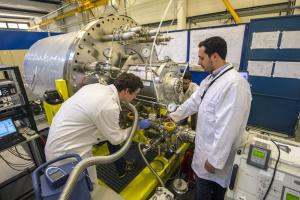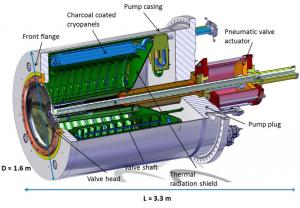Cryopump
Big cold trap under test
4 Jun 2018
-
R.A.
Creating an ultra-high vacuum inside the vast toroidal chamber of the ITER Tokamak—the aptly named "vacuum vessel"—is imperative to initiating plasma operations.
"No one has ever built a cryopump comparable to this one," says ITER vacuum engineer Roberto Salemme (right). The 3.4-metre-long, 8-tonne component is being tested in a laboratory that the ITER vacuum team has set up in the neighbouring CEA-Cadarache.
Mechanical pumps will do the first part of the job, evacuating the air and most of the molecules from the 1,400 m³ vessel and reducing pressure to 1/10,000th that of the atmosphere (pressure is how vacuum is measured).
This, however, will not be sufficient. The quality of the vacuum needed on ITER is in the range of 1/10,000,000,000th that of the atmosphere, close to the deep-space void and impossible to achieve with a mechanical pumping system.
By chance, there is a simple law of physics that can take over when pumping machines reach their limit.
When a molecule or an atom encounters an extremely cold surface, it loses the best part of its energy and slows down to near immobility. This phenomenon is called "adsorption" and its intensity is proportional to surface temperature: the colder the surface, the more irresistible its holding power ...
A cryogenic pump—or cryopump for short—is based on this very principle. In ITER, there will be six torus cryopumps positioned around the vacuum vessel and entrusted with a double mission: perfecting the high vacuum inside the vacuum vessel prior to operation and evacuating helium ash, unburnt fuel and all exhaust gases during plasma shots. Another two cryopumps will be installed on the cryostat to provide the vacuum that thermally insulates the magnet system from the environment.
Every ITER cryopump is equipped with 28 "cryopanels" that will be cooled down to 4.5 K (minus 268.5 °C) by a flow of supercritical helium. These extremely cold surfaces will make an extremely effective particle trap.
The ITER cryopumps are based on a simple law of physics: when a molecule or an atom encounters an extremely cold surface, it loses the best part of its energy and slows down to near immobility—a phenomenon know as "adsorption."
The cryopanels (one metre long, 20 centimetres wide) are coated with a very fine, porous carbon matrix obtained from ground coconut-shell charcoal. Despite their relatively small size, they provide an immense surface for particles to stick to: if developed (flattened out), each carbon matrix would cover 5.5 square kilometres—an area close to 13 ITER platforms.
In August last year, a pre-production cryopump for the torus pumping system, built in collaboration by the ITER Organization and the European Domestic Agency, was delivered to the ITER site. The massive and highly sophisticated component is presently being tested in a laboratory that the ITER vacuum team has set up in the neighbouring CEA-Cadarache, close to the hall that hosts the WEST tokamak.
"No one has ever built a cryopump comparable to this one. It's absolutely unique and we have to familiarize ourselves with it," says Roberto Salemme, the ITER vacuum engineer who oversees the small team from the Air Liquide-40/30 consortium implementing the test program.
The ITER cryopumps will connect directly to either the vacuum vessel (1,400 cubic metres) or the cryostat (8,500 cubic metres). In order to mimic these conditions, a "dome" (0.4 cubic metres) has been installed to seal the open end (left) of the pre-production cryopump.
The valve inside the cryopump—the world's largest all-metal high vacuum valve—is one of the main focuses of the tests. Its head is 80 centimetres in diametre, weighs 80 kilos and travels along a 40-centimetre shaft stroke. When closing, it must lock with a precision of 0.1 millimetre to tighten its all-metal seal.
"We need to characterize the valve's mechanical properties and behaviour and precisely measure the forces that need to be exerted to move it along the shaft and obtain the required sealing at both atmospheric pressure and under vacuum," explains Roberto.
Once installed in the ITER machine, the cryopump will connect directly to the vacuum vessel. In order to mimic this configuration in the lab, the pump has been equipped with a dome that seals its open end and allows the creation of a vacuum inside—not ITER-grade, but sufficient to characterize the mechanical operation of the valve in "real" conditions.
There is a lot that still needs to be explored, measured and characterized before the cryopumps can enter series fabrication, and tests under cryogenic conditions will be essential to establishing the detailed succession of ITER operational sequences.
All that can be done in advance—like the ongoing tests at the ITER lab at CEA— will simplify the commissioning to be performed by the vacuum team for First Plasma and beyond.




